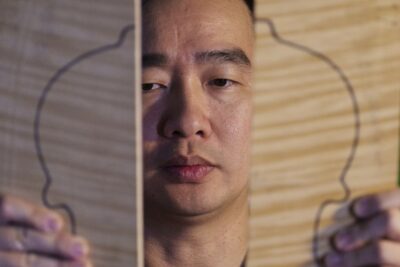Malaysia’s first professional violin maker carves out a rare craft
By Canadian Press on July 17, 2025.

SELANGOR, Malaysia (AP) — Hunched over his workbench, Tan Chin Seng shaves the wooden top plate of a violin, removing thin layers with slow, deliberate strokes. The work is meditative, out of the public eye. For Tan, transforming raw wood into a violin is a labor of artistry and love.
The 45-year-old is Malaysia’s first professional violin luthier, or maker of string instruments like violins, cellos and guitars. Over the past decade, he has earned international accolades. Now he mentors a new generation of makers in a field still little-known in Southeast Asia.
Traditionally, violin luthiers are associated with Europe, where masters like Antonio Stradivari and Giuseppe Guarneri shaped the modern violin. The craft has spread globally, with thriving communities now in China, Japan, South Korea and Taiwan.
Tan’s path to violin-making was unconventional. A computer science graduate who doesn’t play the violin, he was helping in his family’s food business and co-owned a music school. In 2010, a trip to China to restore an aging violin sparked a deeper fascination with the instrument’s construction.
Curiosity led him to apprentice with Chinese luthier Han Zhao Sheng, and he built his first violin.
“After completing the first violin, I knew this craft was for me,” Tan said. “There’s woodworking, carpentry, artistic design. There’s chemistry, acoustics, physics — everything about violin-making, I like it. Turning wood into music is just amazing.”
What followed was, in Tan’s words, a “crazy” devotion. He flew back and forth to Beijing for more training, then traveled to Italy to study under other luthiers. In the early days, he would spend up to 16 hours a day hunched over wood, perfecting every curve and contour. In 2015, he committed to violin-making full time.
The process is painstaking, often taking hundreds of hours to create a single violin and requiring intense focus. His studio, Deciso, located in a suburb near Kuala Lumpur, is cluttered with chunks of aged wood, chisels and jars of hand-mixed varnishes.
Tan crafts up to 10 instruments a year, using spruce for the top plate — the wood is prized for its resonance — and maple for the back, sides and neck. Sourced from Europe and at an annual wood fair in Shanghai, they are aged for years to ensure tonal quality and prevent warping and cracking.
Each violin begins with carving and smoothing the wooden boards to precise dimensions. Tan said the top and back plates are shaped to exact thicknesses that affect resonance. The ribs are bent and assembled, and the scroll is hand-carved at the neck. Varnish — often a luthier’s secret blend — is applied in thin layers for protection and tonal influence. The last steps include cutting the bridge and stringing the instrument.
Tan’s early years were challenging. Some Malaysian clients compared his handmade work to mass-produced instruments. But business grew after he won international awards in Italy and beyond.
Today, he builds violins — and occasionally violas and cellos — mainly on commission. Half of his clients come from abroad including France, Germany and Hong Kong. Each violin sells for 12,000 euros ($14,000).
Tan’s journey has inspired others. While most of his students are musicians and young people, few pursue it as a trade due to the demands of the craft. Still, some have followed in his footsteps including Chan Song Jie, Malaysia’s first female violin luthier.
Today, there are two other full-time violin luthiers in the country, both trained by him. Tan notes that the domestic market is still too small to support many more.
“I would say passion is not enough,” Tan said. “We’re all crazy. Everyone in this workshop — you see — they’re all crazy. We just love the work too much.”
Eileen Ng, The Associated Press
-18




